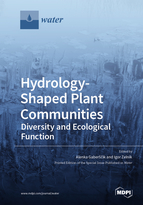Hydrology-Shaped Plant Communities: Diversity and Ecological Function
A special issue of Water (ISSN 2073-4441). This special issue belongs to the section "Biodiversity and Functionality of Aquatic Ecosystems".
Deadline for manuscript submissions: closed (31 January 2021) | Viewed by 30444
Special Issue Editors
Interests: plant ecology; ecosystems; intermittent lake
Interests: wetlands; rivers; lakes; environmental parameters; macrophytes; macroinvertebrates; diatoms
Special Issues, Collections and Topics in MDPI journals
Special Issue Information
Dear Colleagues,
Hydrological conditions, such as the level of the water table in wetlands and water depth in other aquatic ecosystems, determine species composition and the diversity of plant communities and their functioning, as well as functional traits and strategies of the present species. Hydrological conditions depend on the climate and geomorphological features of an area. Deviation from optimal hydrological conditions may result in the reduced vitality of individual species that affect competitive relations, resulting in an altered species composition of plant communities. The success of plants depends primarily on their ability to overcome stress conditions caused by excess and/or shortage of water in a habitat. The sensitivity of different species is reflected in reduced growth or even their extinction. Due to global climate changes, the regional precipitation regimes have been changing, and thus, so has the duration of the periods of waterlogged or flooded soils in wetlands and the fluctuation of the water level in water bodies.
The aim of this Special Issue is to gather knowledge and increase the understanding on the structure and functioning of water-shaped plant communities in different wetlands and/or water bodies and to show the possible trends of the changes that occur due to changing water regime.
Assoc. Prof. Dr. Alenka Gaberščik
Assoc. Prof. Dr. Igor Zelnik
Guest Editors
Manuscript Submission Information
Manuscripts should be submitted online at www.mdpi.com by registering and logging in to this website. Once you are registered, click here to go to the submission form. Manuscripts can be submitted until the deadline. All submissions that pass pre-check are peer-reviewed. Accepted papers will be published continuously in the journal (as soon as accepted) and will be listed together on the special issue website. Research articles, review articles as well as short communications are invited. For planned papers, a title and short abstract (about 100 words) can be sent to the Editorial Office for announcement on this website.
Submitted manuscripts should not have been published previously, nor be under consideration for publication elsewhere (except conference proceedings papers). All manuscripts are thoroughly refereed through a single-blind peer-review process. A guide for authors and other relevant information for submission of manuscripts is available on the Instructions for Authors page. Water is an international peer-reviewed open access semimonthly journal published by MDPI.
Please visit the Instructions for Authors page before submitting a manuscript. The Article Processing Charge (APC) for publication in this open access journal is 2600 CHF (Swiss Francs). Submitted papers should be well formatted and use good English. Authors may use MDPI's English editing service prior to publication or during author revisions.
Keywords
- hydrology
- wetlands
- rivers
- lakes
- ponds
- plant communities
- plant diversity
- functional traits
- ecological function
- changes of water regime
- hydromorphological alterations







